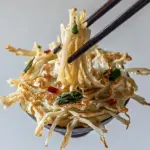Chinese Steamed Egg, also known as egg custard or steamed egg pudding, is a dish that embodies comfort, simplicity, and tradition. This recipe has been loved in Chinese households for generations, not only for its smooth, custard-like texture but also for its delicate, soothing flavor. With just a few ingredients—eggs, water or stock, and a touch of seasoning—it transforms into a velvety bowl of nourishment. Unlike scrambled or fried eggs, which tend to be firmer and heavier, steamed eggs are prepared gently over steam, which results in a silky, melt-in-the-mouth consistency that feels almost luxurious.
What makes this dish so appealing is its adaptability. It can be enjoyed plain for a minimalist experience or dressed up with soy sauce, sesame oil, scallions, or even bits of seafood and meat for something heartier. Whether served at breakfast, offered as part of a family dinner, or enjoyed as a light supper, it fits into any meal with ease. Beyond taste, steamed eggs represent warmth and home-cooked comfort, reminding many of family gatherings, childhood meals, and cultural traditions that never fade.
Full Recipe:
Ingredients
-
3 large eggs
-
1 1/2 cups warm water (or chicken stock)
-
1/4 teaspoon salt
-
1 teaspoon sesame oil
-
Soy sauce and chopped scallions (for garnish)
Directions
-
Crack the eggs into a bowl and whisk until smooth.
-
Gradually add warm water or chicken stock while whisking to ensure a consistent mixture.
-
Strain the mixture through a fine sieve into a shallow heatproof dish for a silky texture.
-
Cover the dish with plastic wrap or foil to prevent water droplets from dripping in.
-
Place the dish into a steamer and cook over medium-low heat for 10–15 minutes, until the eggs are set but still soft and custardy.
-
Remove from the steamer, drizzle with soy sauce and sesame oil, then garnish with chopped scallions before serving.
Nutrients
-
Calories: ~120 kcal per serving
-
Protein: 8 g
-
Carbohydrates: 2 g
-
Fat: 9 g
-
Fiber: 0 g
-
Sugar: 1 g
Why This Recipe Stands Out
What makes Chinese steamed egg truly unique is its elegance in simplicity. Few dishes demonstrate how humble ingredients can be elevated into something so satisfying. Unlike boiled eggs, which are dense, or scrambled eggs, which can be heavy, steamed eggs take on a custard-like consistency that feels delicate yet deeply comforting. The process itself is calming and unhurried—gentle steaming allows the mixture to set into a perfectly smooth custard without fuss or complication.
This dish also stands out because it’s incredibly forgiving and versatile. Beginners can achieve impressive results with minimal effort, while seasoned cooks can explore endless variations with added toppings or seasonings. Shrimp, minced pork, mushrooms, or even a drizzle of chili oil can instantly change its character, making it as simple or elaborate as you want it to be. Steamed eggs also adapt beautifully to different meal times. It can be a light breakfast, a quick side dish, or even the star of a dinner table when paired with rice and vegetables. This balance of simplicity, adaptability, and refinement is what makes it such a remarkable recipe.
The Benefits of the Ingredients
The ingredients in this recipe are not only easy to find but also highly nourishing. Eggs form the foundation, and they are widely considered a nutritional powerhouse. Packed with protein, essential amino acids, healthy fats, and vitamins like B12 and D, eggs provide long-lasting energy and support overall health. They are also budget-friendly, making this dish accessible to nearly everyone.
The addition of water—or better yet, chicken stock—does more than just thin the eggs. It ensures a light, airy texture while also infusing extra flavor if stock is used. Soy sauce introduces umami depth, enhancing the natural richness of the eggs, while sesame oil adds a fragrant nuttiness that lingers pleasantly on the palate. Finally, scallions brighten the dish with a crisp, fresh note, balancing the richness with a subtle sharpness.
Another benefit is that this dish is steamed, not fried. Cooking by steam preserves the nutrients while avoiding unnecessary oil, making it a lighter, healthier choice. Its gentle preparation also makes it suitable for people of all ages, from children to the elderly, and it is especially soothing for those who may need an easy-to-digest meal. Altogether, these simple ingredients come together to create a dish that is wholesome, flavorful, and nourishing without being heavy.
Cooking Tips
Although this recipe is simple, a few key tips can help you achieve the perfect silky texture. First, always whisk the eggs thoroughly to ensure an even mixture before adding the liquid. When incorporating the water or stock, pour it in gradually while whisking to prevent streaks or separation. Straining the mixture through a fine sieve before steaming is a small but important step—it eliminates bubbles and any bits of unblended egg, creating the smooth, glassy surface that makes steamed egg so appealing.
Heat control is another crucial factor. Steam the eggs gently over medium-low heat. If the heat is too high, the custard may overcook, creating an uneven texture with bubbles or holes. Covering the dish during steaming is also essential, as it prevents condensation from dripping onto the eggs and disturbing their silky surface.
The egg-to-water ratio matters, too. The general rule is about half a cup of water for every egg, but this can be adjusted to personal taste. Less water creates a firmer custard, while more water results in a softer, wobblier texture. Using stock instead of plain water adds richness without complicating the method. Lastly, always add toppings after steaming to preserve the delicate custard, and be mindful not to overwhelm the eggs with too many bold flavors.
Serving Suggestions
Chinese steamed egg’s versatility shines in the many ways it can be served. On its own, it makes a comforting breakfast, especially when paired with congee or steamed rice. For lunch or dinner, it works well as a side dish next to stir-fried vegetables, braised meats, or grilled fish. In a family-style meal, it often appears as one of several shared dishes, offering balance alongside richer and more heavily seasoned foods.
For a heartier version, minced pork, chicken, or even small shrimp can be incorporated into the egg mixture before steaming, adding protein and texture. Mushrooms or dried shrimp are also excellent choices for deeper umami notes. To add a modern twist, you might finish the dish with a drizzle of chili oil, crispy garlic, or even a sprinkle of furikake for an East-meets-West fusion flair.
At dim sum restaurants, steamed egg is often served in small individual bowls, making it a delicate appetizer that sets the stage for larger dishes. It also makes a soothing choice for those recovering from illness or simply in need of a light, gentle meal. Whether traditional or experimental, it always delivers warmth and satisfaction.
Conclusion
Chinese steamed egg is more than just a recipe—it is a reflection of culinary tradition, comfort, and the power of simplicity. With only a handful of ingredients, it creates a dish that is silky, nourishing, and endlessly adaptable. Its cultural roots run deep, yet its appeal is universal, as anyone who has tasted its custard-like texture can appreciate its quiet elegance.
By learning to prepare steamed egg, you’re not just cooking—you’re embracing a tradition that has been passed down for generations. It is the kind of dish that can bring families together, soothe the soul after a long day, or serve as a gentle reminder of the beauty of simplicity. Whether you enjoy it plain, garnished with scallions, or enriched with flavorful toppings, steamed egg proves that comfort food does not need to be complicated.
This timeless dish deserves a place in every home kitchen, not just for its taste and nutritional value but for the sense of warmth and connection it brings. Each silky spoonful carries with it a story of heritage, nourishment, and care—a reminder that sometimes, the simplest meals leave the most lasting impressions.






